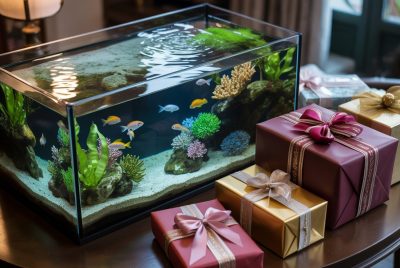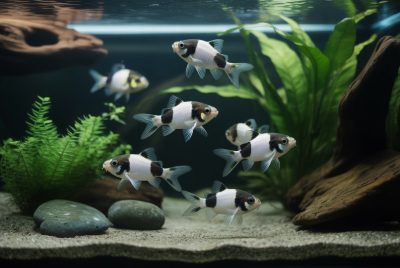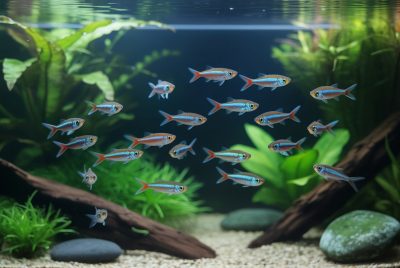Best Fish Food for Healthy Aquarium Fish
*We may earn a commission for purchases made using our links. Please see our disclosure to learn more.
The soft glow of the aquarium light illuminated the tank as I watched my beloved fish swimming listlessly near the bottom. Their once-vibrant colors had dulled, and their usual enthusiastic feeding behavior had turned into reluctant picking at their food. That moment of realization hit me like a wave – I had been failing my aquatic companions with poor-quality fish food that wasn’t meeting their nutritional needs.
What started as a simple hobby had become a passionate journey into understanding the intricate world of fish nutrition. Through countless hours of research, trial and error, and heartbreaking losses, I discovered that choosing the best fish food isn’t just about convenience – it’s about providing our underwater friends with the foundation for a healthy, vibrant life.
“The quality of fish food directly impacts not just the health of your fish, but their behavior, coloration, and overall quality of life in captivity.”
– Marine Biology Research Institute
Key Takeaways
- Quality ingredients matter more than price – Premium fish foods with whole fish, vegetables, and minimal fillers provide superior nutrition
- Species-specific nutrition is crucial – Different fish types require different protein levels, nutrients, and feeding approaches
- Feeding frequency and portion control prevent water quality issues and obesity in fish
- Variety in diet promotes better health, natural behaviors, and enhanced coloration
- Storage and freshness significantly impact nutritional value and food safety
Top 4 Best Fish Food
1. TetraMin Tropical Flakes
TetraMin Tropical Flakes are a top-rated, nutritionally balanced option for freshwater tropical fish. Designed to support immune health, vibrant color, and active energy levels, these flakes are easy to digest and reduce fish waste. With over 17,000 positive reviews and trusted by aquarium enthusiasts worldwide, this is one of the best fish food choices for daily feeding. Suitable for all life stages and formulated with a clean-water formula, TetraMin helps keep your aquarium clean while keeping your fish thriving.
When looking for the best fish food to keep your tropical fish healthy and vibrant, TetraMin Tropical Flakes consistently tops the list. Its balanced flake formula provides the daily nutrition your fish need while minimizing water waste and tank debris. Whether you’re a beginner or seasoned aquarist, TetraMin offers a reliable and affordable feeding solution that supports immune health and vibrant coloration. Available in multiple sizes, it’s a go-to for those seeking long-term quality and value in their aquarium care routine.
- Nutrition-rich formula: Packed with essential vitamins and minerals to promote overall fish health and immune support.
- Clean water formula: Designed to reduce waste and cloudiness in tanks, keeping water clearer for longer.
- Trusted by hobbyists: A bestseller with thousands of high ratings and consistent performance across fish species.
- Flakes may crumble: Can create smaller particles that some fish might ignore or leave uneaten.
- Not ideal for bottom feeders: Sinks slowly, which may limit access for fish that prefer food at the bottom.
- May require supplementation: For optimal diet variety, consider alternating with pellets or freeze-dried treats.
2. Tetra BloodWorms
Tetra BloodWorms offer a protein-rich, freeze-dried treat ideal for both freshwater and saltwater fish. Sourced from real bloodworms, this seafood snack enhances color, energy, and vitality in tropical species. Great as a supplement to your fish’s regular diet, these worms are an excellent choice for picky eaters or fish that crave a more natural food texture. Affordable, easy to portion, and mess-free, Tetra BloodWorms are a staple among aquarists seeking the best fish food options for variety and enrichment.
If you’re looking to boost your fish’s diet with a nutrient-dense, protein-rich snack, Tetra BloodWorms deserve a spot on your shelf. These freeze-dried seafood bites are a favorite among tropical fish and ideal for encouraging finicky eaters. While not a complete food, they complement a balanced diet and help mimic natural feeding behavior. For those researching the best fish food to enhance color and health, Tetra BloodWorms are a smart, convenient addition to any feeding routine.
- High-protein treat: Boosts fish energy, growth, and coloration—great for conditioning or picky eaters.
- Freeze-dried convenience: Offers the benefits of live food without the mess, odor, or risk of parasites.
- Versatile use: Suitable for both freshwater and saltwater species at all life stages.
- Not a complete diet: Should be used as a supplement, not a daily staple food.
- Can cloud water: Overfeeding or fine particles may lead to temporary water cloudiness.
- Small quantity: The 0.25 oz size is great for trying, but frequent buyers may need a larger pack.
3. Fluval Bug Bites Color Enhancing Fish Food
Fluval Bug Bites Color Enhancing Granules are a premium daily food designed to bring out vibrant colors in tropical fish. Made with black soldier fly larvae as the first ingredient, this nutrient-packed formula mimics the natural insect-based diet of fish. Ideal for medium to large freshwater species, these granules are slow-sinking, easy to digest, and rich in salmon protein, vitamins, and omega-3s. For aquarists seeking the best fish food to naturally boost coloration and activity, Fluval Bug Bites deliver quality and results in every bite.
Looking for the best fish food to enhance your fish’s color and health? Fluval Bug Bites Color Enhancing Granules are a standout choice. Featuring an insect-based formula and natural salmon protein, this food promotes stronger immunity, vibrant hues, and a more active aquarium. Perfect for tropical fish owners who value quality ingredients and minimal fillers, these granules strike the balance between natural nutrition and scientific formulation.
Pros
- Insect-based formula: Mimics natural fish diets with high-protein black soldier fly larvae.
- Color-enhancing nutrients: Supports rich, vibrant colors with added salmon and vitamins.
- Slow-sinking granules: Perfect for mid-to-bottom dwellers and less waste in the tank.
Cons
- Not ideal for small fish: Granule size may be too large for nano or small-mouthed species.
- Slight odor: Natural ingredients can give off a stronger scent compared to flakes.
- May settle quickly: Fast-sinking in some tanks depending on water flow, reducing surface feeding time.
4. Hikari Tropical Sinking Wafers
Hikari Tropical Sinking Wafers are specially formulated for bottom-dwelling fish like catfish, loaches, and plecos. Designed to sink quickly and retain shape, these wafers minimize mess and ensure fish get their full meal without clouding the water. Enriched with spirulina and other high-quality marine proteins, the wafers support immune health, vibrant color, and long-term vitality. For aquarists looking for the best fish food for bottom feeders, Hikari offers proven performance trusted by hobbyists worldwide.
When it comes to feeding bottom feeders, Hikari Tropical Sinking Wafers consistently rank among the best fish food options available. With a nutrient-rich formula including spirulina and seafood proteins, they provide excellent support for immune health and coloration. Their durability in water ensures your catfish and loaches can graze naturally without polluting the tank. For serious aquarists, Hikari delivers reliable quality and nutrition where it matters most—at the bottom of the tank.
- Ideal for bottom feeders: Sinks quickly and stays intact, perfect for catfish, loaches, and plecos.
- Enhanced with spirulina: Promotes color enhancement and a strong immune system.
- Low waste formula: Resists disintegration, reducing tank cloudiness and cleanup.
- Not suitable for top swimmers: Sinks too fast for mid- or surface-feeding species.
- Might be too large: Some smaller bottom feeders may struggle with full wafers.
- Higher price point: Premium quality comes at a slightly higher cost per ounce.
My Emotional Journey into Fish Nutrition
My relationship with aquarium keeping began innocently enough – a small betta fish in a desktop tank seemed like the perfect low-maintenance pet. But as I watched my fish thrive and began adding more species to larger tanks, I realized that feeding them wasn’t as simple as sprinkling generic flakes twice a day.
The turning point came when I noticed my angelfish developing faded coloring and my corydoras becoming less active. Despite maintaining proper water parameters, something was clearly wrong. After consulting with experienced aquarists and diving deep into fish nutrition research, I discovered that my bargain-brand fish food was essentially junk food for my aquatic pets.
Understanding Fish Nutritional Needs
Fish, like all animals, require a balanced diet containing proteins, fats, carbohydrates, vitamins, and minerals. However, their specific needs vary dramatically based on species, age, and natural feeding behaviors. Carnivorous fish need high-protein diets with minimal plant matter, while herbivorous species thrive on algae-based foods with lower protein content.
The Protein Foundation
Quality protein sources form the backbone of excellent fish nutrition. Look for foods listing whole fish meal, shrimp meal, or other identifiable protein sources as primary ingredients. Avoid foods with generic “fish meal” or excessive amounts of plant-based fillers that don’t provide species-appropriate nutrition.
My first major upgrade involved switching to a premium flake food with salmon meal as the first ingredient. Within weeks, I noticed improved activity levels and the gradual return of natural coloration in my tropical community tank.
Common Challenges in Fish Feeding
Overfeeding and Water Quality Issues
Perhaps the most common mistake I made early in my aquarium journey was overfeeding. The general rule of thumb – feed only what fish can consume in 2-3 minutes – seems simple but requires discipline and observation. Excess food decomposes rapidly, creating ammonia spikes that stress fish and promote algae growth.
Species Compatibility in Community Tanks
Feeding a mixed community tank presents unique challenges. Fast-swimming fish often monopolize surface foods while bottom-dwellers go hungry. I learned to use multiple feeding strategies: floating pellets for surface feeders, sinking wafers for bottom fish, and carefully timed feedings to ensure all species receive adequate nutrition.
Maintaining Food Freshness
Fish food loses nutritional value over time, especially when exposed to air, light, and moisture. I discovered that storing opened containers in cool, dry places and using smaller package sizes ensures maximum freshness. Frozen and freeze-dried foods require even more careful handling to maintain their nutritional integrity.
Three Key Transformations in My Fish Feeding Approach
Transformation 1: Quality Over Quantity
My first major shift involved investing in higher-quality foods despite the increased cost. Premium fish foods with superior ingredients meant healthier fish, better water quality, and ultimately lower long-term costs through reduced disease and mortality.
The improvement was remarkable – fish showed increased activity, enhanced colors, and more natural behaviors. My angelfish began displaying courtship behaviors I’d never seen before, and my tetras formed tighter, more active schools.
Transformation 2: Embracing Dietary Variety
Natural fish diets include incredible variety, from algae and plant matter to insects, crustaceans, and smaller fish. I began supplementing staple foods with frozen bloodworms, brine shrimp, and vegetable-based options.
This variety not only improved nutrition but triggered natural hunting and foraging behaviors. Watching my fish eagerly pursue live or frozen foods reminded me why proper feeding is so crucial to their wellbeing.
Transformation 3: Understanding Individual Species Needs
Each fish species evolved with specific dietary requirements. My bottom-feeding corydoras needed sinking foods they could root through substrate to find, while my surface-dwelling guppies preferred small, floating options they could easily consume.
I learned to research each species’ natural diet and feeding behaviors, then select foods that matched their evolutionary needs. This species-specific approach dramatically improved the health and behavior of all tank inhabitants.
The Science Behind Quality Fish Food
Understanding fish nutrition helped me make informed decisions about food selection. Fish require essential amino acids for growth and tissue repair, omega-3 fatty acids for immune function and coloration, and specific vitamins for metabolic processes.
Quality manufacturers conduct feeding trials and nutritional analysis to ensure their products meet fish requirements. Look for foods that list specific nutrient percentages and avoid those with vague ingredient lists or excessive artificial additives.
Practical Feeding Strategies for Different Environments
Community Tank Feeding
Managing multiple species requires strategic feeding approaches. I use a combination of floating pellets, slowly sinking flakes, and bottom wafers to ensure all fish receive appropriate nutrition. Feeding smaller amounts multiple times daily prevents aggressive competition and ensures shy species get adequate food.
Species-Specific Tanks
Single-species tanks allow for more targeted nutrition. My discus tank receives high-protein foods designed for their specific needs, while my goldfish tank focuses on easily digestible options that won’t cause swim bladder issues.
Overcoming Feeding Obstacles
Picky Eaters
Some fish species or individual fish can be extremely selective about food. I’ve found success gradually mixing new foods with familiar ones, allowing fish to adjust to new flavors and textures over time. Patience and persistence usually overcome initial resistance.
Vacation Feeding Challenges
Extended absences require careful planning. Automatic feeders work for some situations, but I prefer preparing pre-measured portions and training reliable friends or family members in proper feeding techniques. Temporary fasting is often safer than overfeeding during owner absence.
The Emotional Rewards of Proper Nutrition
Watching fish thrive on quality nutrition provides immense satisfaction. Seeing vibrant colors develop, observing natural behaviors emerge, and witnessing successful breeding attempts validates the time and effort invested in proper feeding.
The connection between fish and keeper deepens when you understand and meet their specific needs. Fish begin recognizing feeding times and may even interact with their caregivers during meals, creating rewarding relationships that enrich the aquarium keeping experience.
Long-term Benefits of Quality Fish Food
Investing in premium fish food pays dividends through improved fish health, reduced veterinary costs, and enhanced aquarium aesthetics. Healthy fish live longer, display better colors, and exhibit more interesting behaviors that make aquarium keeping truly rewarding.
Quality nutrition also supports successful breeding programs for those interested in propagating their favorite species. Well-nourished parent fish produce healthier offspring with better survival rates.
Building a Supportive Fish Keeping Community
Sharing experiences with fellow aquarists accelerates learning and provides valuable support during challenging times. Online forums, local aquarium societies, and specialty fish stores offer opportunities to connect with experienced keepers who can share feeding wisdom and product recommendations.
Don’t hesitate to ask questions or share your own discoveries. The aquarium keeping community is generally welcoming and eager to help newcomers avoid common mistakes while celebrating successes together.
Conclusion
My journey from casual fish keeper to nutrition-conscious aquarist transformed not only my tanks but my entire approach to animal care. Understanding that fish food quality directly impacts fish health, behavior, and longevity motivated me to invest time and resources in proper nutrition.
The best fish food isn’t necessarily the most expensive, but it is the one that meets your specific fish species’ nutritional needs while maintaining freshness and quality. Start by researching your fish species’ natural diets, then select foods that closely match those requirements.
Remember that feeding fish properly is an ongoing learning process. Stay curious, observe your fish carefully, and don’t be afraid to experiment with different high-quality options. Your fish will reward your efforts with vibrant health, beautiful colors, and engaging behaviors that make aquarium keeping truly fulfilling.
Take the first step today by evaluating your current fish food and considering upgrades that will benefit your aquatic friends. They depend on you for their nutrition, and they deserve the best you can provide.
Frequently Asked Questions
Q: How often should I feed my fish?
A: Most adult fish should be fed once or twice daily, with only as much food as they can consume in 2-3 minutes. Young, growing fish may need more frequent feeding, while some species like goldfish benefit from multiple small meals throughout the day.
Q: Can I mix different types of fish food together?
A: Yes, mixing different high-quality foods can provide nutritional variety that benefits fish health. Combine flakes, pellets, and frozen foods to create a varied diet that mimics natural feeding patterns.
Q: How long does fish food stay fresh after opening?
A: Most dry fish foods remain fresh for 6-12 months after opening when stored properly in cool, dry conditions. Frozen foods should be used within 6 months, while freeze-dried options can last up to 2 years if kept sealed and dry.
Q: Is expensive fish food really worth the extra cost?
A: Premium fish foods typically contain higher-quality ingredients, better nutrition, and less filler material. While more expensive initially, they often provide better value through improved fish health, enhanced coloration, and reduced waste in the aquarium.
Q: What should I do if my fish won’t eat new food?
A: Gradually introduce new foods by mixing small amounts with familiar food over several days. Some fish need time to recognize new foods as edible. Ensure the food is appropriate for your fish species and consider trying different brands or formulations if problems persist.
















